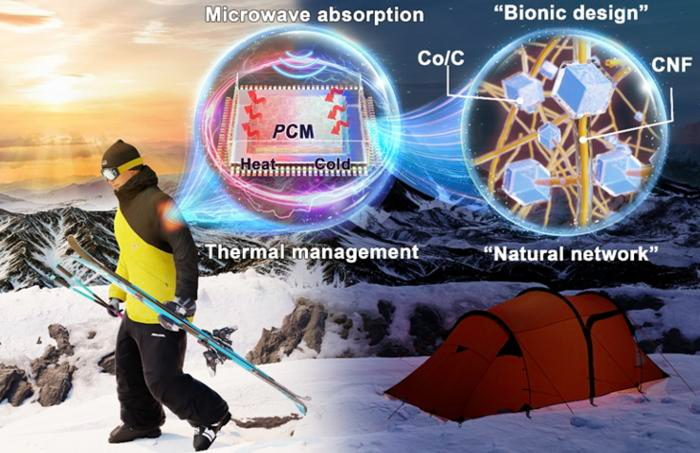In a recent paper published in the journal Nano Energy Research, Chinese researchers at Beijing Normal University have been developing multifunctional composite phase change materials (PCMs) shielding to enhance the electronic devices’ ability to regulate temperature, convert solar energy into thermal energy, and absorb microwaves.
 As a result of the bionic design of the neural network-like aerogel-based composite PCMs, both microwave absorption and thermal management are increased, and in colder climates the solar-thermal conversion can be used to heat devices for normal start-up and keep the device closer to an optimal performance temperature. Image Credit: Beijing Normal University and University of Science and Technology Beijing
As a result of the bionic design of the neural network-like aerogel-based composite PCMs, both microwave absorption and thermal management are increased, and in colder climates the solar-thermal conversion can be used to heat devices for normal start-up and keep the device closer to an optimal performance temperature. Image Credit: Beijing Normal University and University of Science and Technology Beijing
Electronic devices are becoming increasingly sophisticated since they are designed to perform for an ever-increasing variety of purposes. This is evident in the growing capability of personal devices such as phones, tablets, watches, and industrial equipment. However, their increasing complexity might cause performance and safety difficulties. These difficulties include device overheating and microwave emissions, which can cause health problems, limit device performance, and interact with other devices.
PCMs are man-made materials created by mixing several types of components, forming a new material with specific purpose-driven features.
They created a neural network-inspired aerogel that improves thermal management and microwave emission absorption efficiency using bionic design and engineering influenced by biological processes.
Our developed functionally integrated composite PCMs provide a prospective application of highly integrated and miniaturized electronic devices in complex and changeable outdoor environments.
Xiao Chen, Researcher, Institute of Advanced Materials, Beijing Normal University
To ensure that it had the necessary properties—improved thermal management, which optimizes heat dissipation and heat storage, solar-thermal conversion, which allows devices to heat up for normal start-up in cold environments, and microwave absorption—the researchers carefully selected the elements that would be incorporated into their new aerogel shield.
Due to space constraints, they could not stack the various elements, so they had to develop a new composite material with all the required qualities.
Thermally enhanced PCMs have the ability to store and release massive energy as latent heat, they are widely acknowledged for the ability to ensure precise temperature control.
Yang Li, Study First Author and Researcher, Institute of Advanced Materials, Beijing Normal University
As the temperature rises, these composites can shift their phase from solid to liquid, increasing the available heat storage and then back to solid when the temperature drops. However, pure PCMs show no promise in solar-thermal conversion.
Li added, “Bacterial cellulose (BC) is a highly desirable natural biomass due to its numerous advantages including biodegradability, low cost, high purity, renewability, easy modification and functionalization. BC-derived carbon nanofiber through high temperature carbonization has been considered as a promising solar-thermal material.”
Another element would be utilized to solve the problem of microwave emissions.
Recent interest in microwave absorption has focused on metal-organic frameworks due to their exceptional porosity, adjustable pore structure and high specific surface area. Numerous studies have demonstrated that a porous network structure not only provides large specific surface area for absorbing PCMs, but also dissipates microwave energy through scattering or multiple reflection.
Ge Wang, School of Materials Science and Engineering, University of Science and Technology
Finally, the material was wrapped in paraffin wax, which can undergo phases, as a thermal storage strategy. The completed material was evaluated to see how well the composite hybrid aerogel maintained the desired properties.
When testing for solar-thermal conversion to see how effectively the composite might store solar energy for heating a device in colder areas, the aerogel-based composite PCMs absorbed more than 90% of the broadband and the entire light spectrum.
It converted solar energy to thermal energy with over 95% efficiency and had a thermal storage capacity of 122.19 J/g. Finally, microwave absorption tests revealed that the aerogel-based composite PCMs efficiently absorbed incident electromagnetic waves.
Chen concluded, “Our bionically fabricated high-performance and functional integrated aerogel-based composite PCMs with thermal management, solar-thermal conversion and microwave absorption functions show a good prospective application in overcoming overheating or overcooling and EMI of electronic devices.”
Panpan Liu, Yuhao Feng and Xuemei Diao from the Institute of Advanced Materials, Beijing Normal University, Beijing, China and the College of Nuclear Science and Technology, Beijing Normal University, Beijing, China, Peicheng Li from the School of Environment, Beijing Normal University, Beijing, China, and Yan Gao from Beijing Advanced Innovation Center for Materials Genome Engineering, Beijing Key Laboratory of Function Materials for Molecule & Structure Construction, School of Materials Science and Engineering, University of Science and Technology Beijing, Beijing, China are the other study contributors.
The National Natural Science Foundation of China provided financial support for this study.
Journal Reference:
Li, Y., et al., (2024) Neural network-inspired hybrid aerogel boosting solar thermal storage and microwave absorption. Nano Energy Research. doi.org/10.26599/NRE.2024.9120120